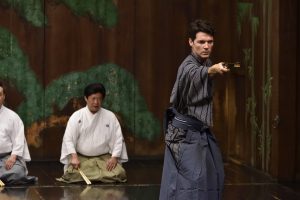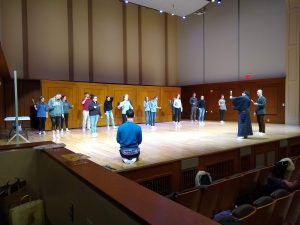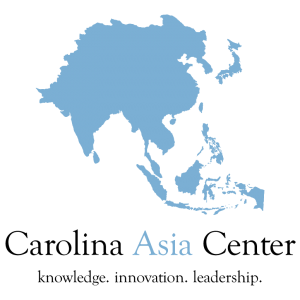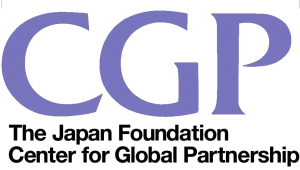by Catherine Zachary

In nearly two weeks to the day, UNC Opera will present their spring production, Kurt Weill’s One Who Says Yes. Weill is known for his modernity and boundary-pushing compositions, but this production will also be rooted in the traditions of Noh Theater. Weill’s opera is based on the Noh play, Taniko by Komparu Zenchiku, and UNC Opera students have been hard at work studying the art and stylings of Noh this semester. The students had the incredible opportunity to work with sensei Shingo Katayama in a 2-day Noh workshop and will get to perform alongside renowned Buyoka performer Umekawa Ichinosuke, who’s an expert in combining traditional Japanese dance with western classical music.
But how did this multicultural production come about?
It goes back to the spring of 2012 when UNC Opera Director Marc Callahan was on sabbatical touring with Le Concert Sprituel in Japan, singing in Purcell’s opera King Arthur. Callahan shares,
“I fell in love with the rich cultural heritage of the country and admired how the Japanese people could live so harmoniously with both their modern way of life and traditional culture. I was particularly drawn to their strong and thriving tradition of Kabuki and Noh theater. As a director, I wanted to immerse myself in these techniques and, as one who studies history, to fully understand these traditions first-hand.
When I decided upon One Who Says Yes as an opera for our season, I knew that I wanted to participate in an intensive Noh workshop and enrolled in the famous Traditional Theater Training program in Kyoto. It was there that I met my sensei Shingo Katayama, who I have had the pleasure of inviting to UNC for a Noh theater workshop with our students.”

Callahan hopes that through cross-cultural mentorship and collaboration with artists such as Shingo Katayama and Umekawa Ichinosuke, UNC Opera will continue to grow as an active conduit for global dialogue and collaboration. Throughout the semester the students have been learning their music and staging for the opera, reading the founding treatises of Noh, and putting these theories into practice – giving them a broader, more global view of what western opera, and their own performances, can be. As Callahan put it,
“Inviting Shingo Katayama to come and work with our students was an incredible experience. Watching their faces light up when he spoke about theater, performed a shimai, and worked with them on stage was so rewarding, as a professor. I held an open dialogue with my students, after his visit, and I was very impressed with what they took away from the course. One piece of wisdom that stood out: ‘Always approach your practice with a beginner’s spirit.’
And having Umekawa Ichinosuke perform with the students is a dream come true! For the students to work alongside a renowned dancer with such talent, poise, elegance, and subtle emotion will be incredibly inspiring. They will have so much to learn from sharing the stage with him. Also, I hope that they will recognize the ways in which he has combined performance technique from the East and West to find true, unspoken dialogue between our cultures.”
This project has also allowed the students to hone their research skills. They have created 5 different kakejiku (hanging scrolls) to display their group research projects and help introduce audience members to the concepts of Noh theater that they will experience during the performances. These kakejiku are part of a multimedia exhibit that will be presented in the rotunda of Hill Hall, right outside Moeser Auditorium where the performances will take place. “Noh World” will also feature video stations where the audience can watch Noh performances, interactive stations to try on Noh masks and use fans, and oishi (yummy) Japanese treats to snack on while exploring the exhibit!
 Also featured pre-show each night will be a lecture by Professor Tim Carter, titled “Berlin Meets Japan: Bertolt Brecht and Kurt Weill, 1930.”
Also featured pre-show each night will be a lecture by Professor Tim Carter, titled “Berlin Meets Japan: Bertolt Brecht and Kurt Weill, 1930.”
“We are especially fortunate to have one of our own, Professor Tim Carter, speak on Kurt Weill and his forays into the world of Japanese music and theater traditions. Professor Carter is one of the world’s foremost authorities on opera and we are very excited to have him place this particular work in context,” Callahan says.
“In short, this experience – the combined exhibit, lecture, and performance – will be a one-of-a-kind event. The chances to see someone like Umekawa Ichinosuke perform are rare, at best! In addition, we hope that this event will showcase a tradition of which we have little awareness, offering a beautiful and curious evening of great history, dance, and opera!”
One Who Says Yes will be presented in James and Susan Moeser Auditorium, Hill Hall, on Saturday, March 30 at 8:00 pm and Sunday, March 31 at 7:30 pm. The pre-show lecture will be held at 7:15 pm and 6:45 pm respectively in Hill Hall 103, just off the rotunda. Tickets are $10 general admission, $5 for students and UNC faculty/staff (the box office will open 1 hour before the show). The Noh World exhibit in Hill Hall’s rotunda will open 2 hours before the show.
Ichinosuke will perform solo and in collaboration with UNC Music faculty on the first half of each performance night. On Saturday, March 30, he will be joined by UNC Opera Director Marc Callahan, bass-baritone, and pianist Keiko Sekino for Schubert’s “Wasserflut” from Winterreise. On Sunday, March 31, he will be joined by Professor Brent Wissick, cello, and James Rice, piano, for the second movement of Kurt Weill’s Cello Sonata.
To read more about the 2-day Noh Workshop with Shingo Katayama, click here.
These events are made possible through funding from the Carolina Asia Center and The Japan Foundation Center for Global Partnership.


